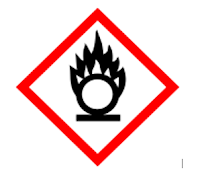Hazard Communication (HazCom)
 |
| Chemical |
Disclaimer: This blog is for general information purpose only. The goal is to give an overview of what is Hazard Communication and its importance in maintaining workplace safety.
Occupation Safety And Health Administration (OSHA) issued its hazard communication standard (HCS) to develop chemical information through the Safety Data Sheet (SDS) and labelling.
What does Hazard Communication mean?
Hazard Communication known as HAZCOM gives a method for identifying classified chemical hazards information to both employer and employee to which they may be exposed. This is designed to protect employees from hazardous chemicals used and stored in the workplace. Training and information be provided to that employee who has been exposed to a hazardous chemical.
Hazard chemical are substances that lead to ill health effects such as poisoning and even cancer if exposed to overtime such as,
- Pesticides
- Paints
- Asbestos
- Welding Fumes
- Drugs
- Cleaning Chemicals
- Detergent
Why is Hazard Communication important?
Chemical hazards can be quite dangerous if not handle and stored properly. Not can only illness and injury because of the lack of safety precaution can even lead to death. To provide a safe workplace and train the worker through the Hazard Communication Program.
Hazardous chemical:
Hazardous Chemical mean any chemical classified as health or physical hazards. Chemical manufacturers need to evaluate the hazards of chemical and provide safety data sheet and label to convey such information.
Employer Responsibility:
- Must obtain SDS from manufacturer
- SDS is available with a chemical when needed and in an emergency,
- Must provide a hazard communication program and trained the worker,
- Put in place a written hazard communication program,
- Control measures put in place,
The Hazard Communication Standard (HCL) is now aligned with the Globally Harmonized System of Classification and Labelling of Chemical (GHS)
What is GHS?
GHS stand for a Globally Harmonized System of Classification and Labeling of Chemicals. GHS defines the classes of hazards chemical product and provides information on health and safety data sheet. There are 5 sections of GHS.
1. Hazard Classification
2. Pictogram
3. Signal Word
4. Hazard Statement
5. Precautionary Statement
1. Hazard Classification
Classification of hazards into health, physical and environment under the 29 CFR 1910.1200 (the OSHA HAZCOM standard)
Health Hazards
- Mutagenicity
- Reproductive Toxicity
- Respiratory Sensitizer
- Target Organ Toxicity
- Aspiration Toxicity
Physical Hazards
- Explosive
- Flammable gases, liquids and solid
- Oxidizing gases, liquids and solid
- Gas under pressure
- Pyrophoric liquids and solid
Environmental Hazards:
Aquatic Toxicity
2. Pictogram ( see picture - 1- 1)
GHS uses only 9 pictogram symbols for workplace hazards warning.
1. Exclamation Mark (harmful)
2. Flammable
3. Health Hazards
4. Corrosive
5. Gas under pressure
6. Explosive
7. Oxidizing
8. Aquatic toxicity
 |
| toxic |
3. Signal Word ( see picture - 1- 3)
Signal word indicates the degree of severity of a hazard of chemical. The GHS used two words only,
Danger - for severe hazards
Warning - for less severe hazards
4. Hazard Statement
Hazard statement Indicates the nature of the risk of hazards of a chemical, example: Self-heating; may catch fire,
see below picture-1 (4 and 5) cause damage to the liver and kidney through exposure to the skin,
lightly flammable liquid and vapour
5. Precautionary Statement
Describes the steps to be taken to minimize hazards impact to prevent the adverse effect.
see below picture-1 (4 and 5) wash hand after each use and before eating,
wash the affected area thoroughly with soap and water,
 |
| GHS labelling - picture - 1 |
What is the Safety Data Sheet (SDS):
There are 16 sections that replace the old MSDS is a document that contains information on the chemical/product hazards and safety precaution to work, handle and stored safely.
- Manufacturer's information,
- Composition on the ingredient,
- Hazard identification,
- First-aid measure,
- Fire fighting measures,
- Accidental release measure,
- Handling and storage,
- Exposure control
- Physical and chemical properties
- Stability and reactivity
- Toxicological information
- Ecological information
- Disposal information
- Transport information
- Regulatory information
- Other information
Training and information:
Educate and train workers on the hazards and safe use of chemical, proper handling and storage, proper PPE, information about the label and SDS etc.











